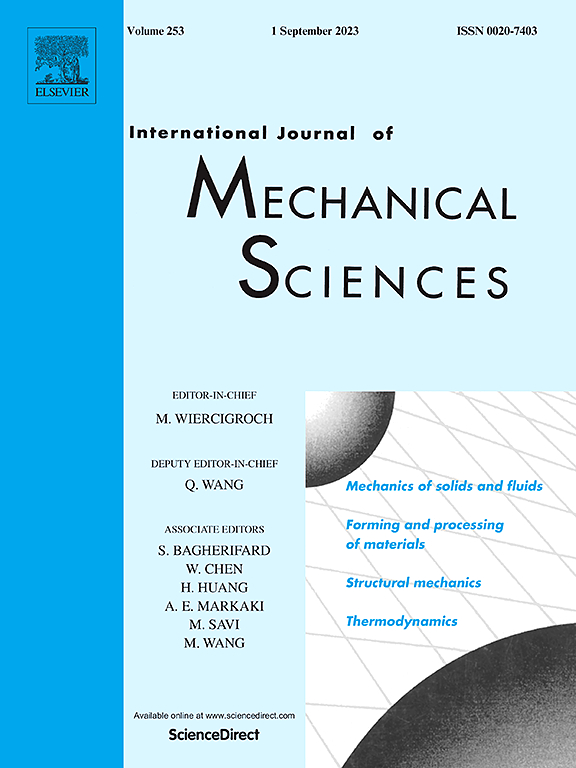基于有效装药的改进聚能形成模型
IF 7.1
1区 工程技术
Q1 ENGINEERING, MECHANICAL
International Journal of Mechanical Sciences
Pub Date : 2025-04-15
DOI:10.1016/j.ijmecsci.2025.110223
引用次数: 0
摘要
聚能装药以其卓越的突防能力而闻名,在军事和民用领域发挥着关键作用,包括武器制造和石油开采。然而,传统的射流形成模型显示出有限的准确性,特别是无法捕捉到在射流尖端观察到的反向速度梯度。为了解决这些问题,本研究在一维准稳定射流形成理论(PER理论)的基础上,创新性地建立了动态有效电荷(DEC)模型。具体而言,提出了一种有效的装药计算方法,以准确确定主动驱动聚能药管坍塌的装药比例。此外,还采用了动态加速度模型来真实地描述尾管的坍塌过程。通过这些改进,DEC模型不仅能够准确地预测射流速度,而且能够有效地捕获射流尖端的反向速度梯度现象。此外,DEC模型解释了射流速度与装药长径比之间的非线性关系,揭示了聚能长径比存在一个极限值,超过该极限值后,装药长度的增加导致速度的增加最小。这些进展为在广泛的工程应用中优化聚能设计提供了重要的理论见解和实践指导。本文章由计算机程序翻译,如有差异,请以英文原文为准。

Improved shaped charge formation model based on the effective charge
Shaped charges, renowned for their exceptional penetration capabilities, play a critical role in military and civilian applications, including armament manufacturing and petroleum extraction. However, traditional jet formation models exhibit limited accuracy, particularly in failing to capture the reverse velocity gradient observed at the jet tip. To address these limitations, this study innovatively developed a dynamic effective charge (DEC) model, building upon the established one-dimensional quasi-steady jet formation theory (PER theory). Specifically, an effective charge calculation method was developed to accurately determine the portion of explosive charge actively driving the collapse of the shaped charge liner. Additionally, a dynamic acceleration model was incorporated to realistically characterize the liner’s collapse process. Through these advancements, the DEC model not only enables accurate predictions of jet velocity but also effectively captures the reverse velocity gradient phenomenon at the jet tip. Moreover, the DEC model explains the nonlinear relationship between the jet velocity and the charge length-to-diameter ratio, revealing that there is a limiting value of the shaped charge length to diameter ratio, beyond which additional increases in charge length result in minimal velocity enhancements. These advancements provide critical theoretical insights and practical guidelines for optimizing shaped charge designs across a broad range of engineering applications.
求助全文
通过发布文献求助,成功后即可免费获取论文全文。
去求助
来源期刊

International Journal of Mechanical Sciences
工程技术-工程:机械
CiteScore
12.80
自引率
17.80%
发文量
769
审稿时长
19 days
期刊介绍:
The International Journal of Mechanical Sciences (IJMS) serves as a global platform for the publication and dissemination of original research that contributes to a deeper scientific understanding of the fundamental disciplines within mechanical, civil, and material engineering.
The primary focus of IJMS is to showcase innovative and ground-breaking work that utilizes analytical and computational modeling techniques, such as Finite Element Method (FEM), Boundary Element Method (BEM), and mesh-free methods, among others. These modeling methods are applied to diverse fields including rigid-body mechanics (e.g., dynamics, vibration, stability), structural mechanics, metal forming, advanced materials (e.g., metals, composites, cellular, smart) behavior and applications, impact mechanics, strain localization, and other nonlinear effects (e.g., large deflections, plasticity, fracture).
Additionally, IJMS covers the realms of fluid mechanics (both external and internal flows), tribology, thermodynamics, and materials processing. These subjects collectively form the core of the journal's content.
In summary, IJMS provides a prestigious platform for researchers to present their original contributions, shedding light on analytical and computational modeling methods in various areas of mechanical engineering, as well as exploring the behavior and application of advanced materials, fluid mechanics, thermodynamics, and materials processing.
 求助内容:
求助内容: 应助结果提醒方式:
应助结果提醒方式:


